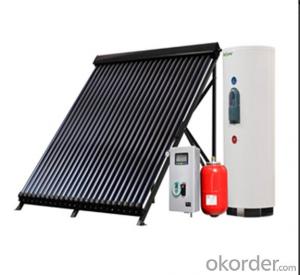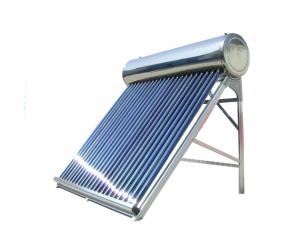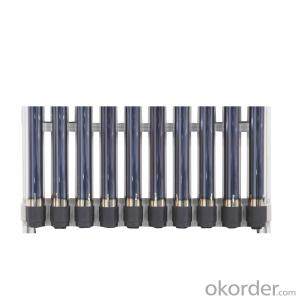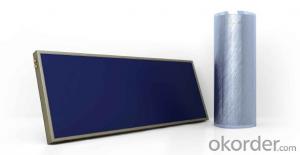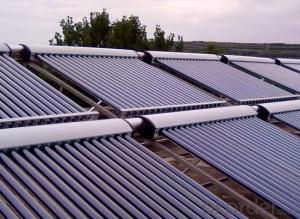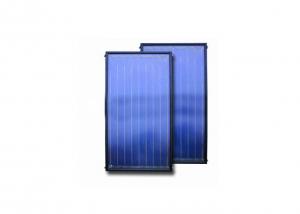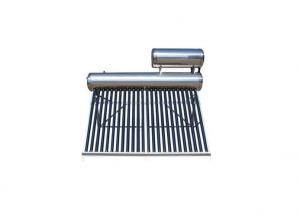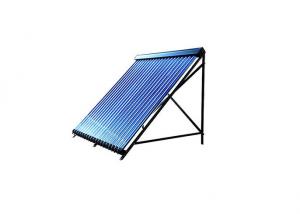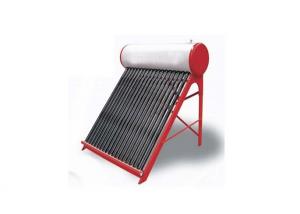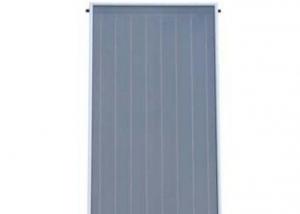Split Solar Heating System with no Copper Coil Inside of Water Tank Model SS-M0
- Loading Port:
- Shanghai
- Payment Terms:
- TT OR LC
- Min Order Qty:
- 20 set
- Supply Capability:
- 1500 set/month
OKorder Service Pledge
OKorder Financial Service
You Might Also Like
1. Structure of Split Solar Heating System with no Copper Coil Inside of Water Tank Model SS-M0
Split Solar Heating System with no Copper Coil Inside Water Tank Model SS-M0 is composed of solar collector, tank with no copper coil, working station and expansion tank, which are linked and controlled by the valves. Solar heating system is really a good supplement of gas or electricity, for when there is rich sunlight in summer, a correctly sized solar system can provide 60%-70% of a household's hot water needs and produces no environmental waste or pollution.
2. Main Features of Split Solar Heating System with no Copper Coil Inside Water Tank Model SS-M0
· Food-grade stainless steel SUS304-2B inner tank
· High heat transfer efficiency
· Combined with auxiliary electricity, gas and other boiler
· Easy installation according to the structure of the room
3. Split Solar Heating System with no Copper Coil Inside Water Tank Model SS-M0 Images (showing the working status and the installation instructure)
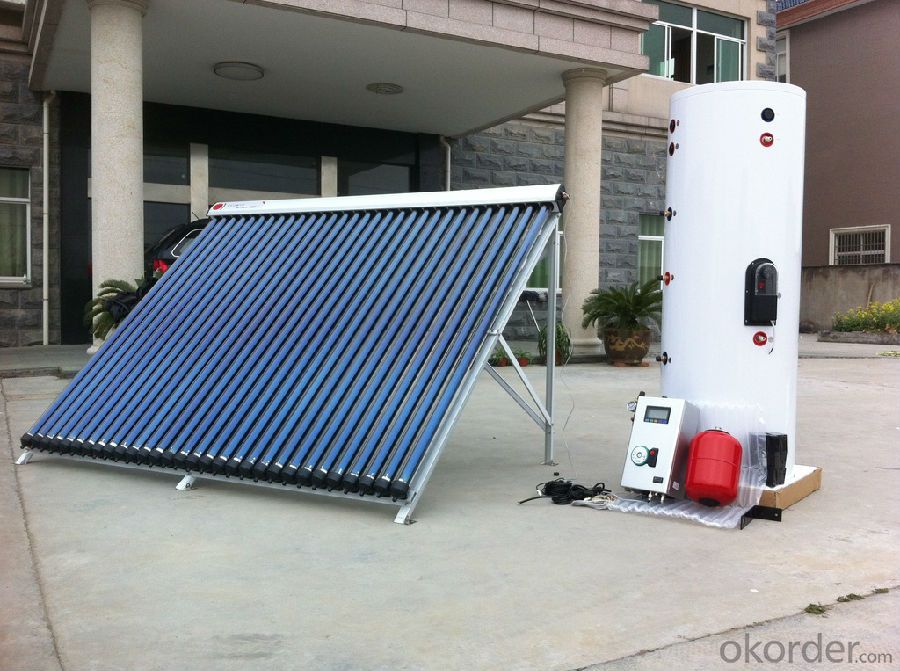

4. Split Solar Heating System with no Copper Coil Inside Water Tank Model SS-M0 Specification
System model | SS-M0-150 | SS-M 0-200 | SS-M 0-250 | SS-M0 -300 | SS-M 0-400 | SS-M0 -500 |
Tank capacity(L) | 150 | 200 | 250 | 300 | 450 | 500 |
Copper coil qty | 1/2 | 1/2 | 1/2 | 1/2 | 1/2 | 1/2 |
Solar collector model | SC-H-15/20 | SC-H-20/24 | SC-H-25/30 | SC-H-30/20 | SC-H-20/24 | SC-H-25/30 |
Solar collector qty | 1/1 | 1/1 | 1/2 | 1/2 | 2/2 | 2/2 |
Controller model | SR868C8 | SR868C8 | SR868C8 | SR868C8 | SR868C8 | SR868C8 |
Work station model | VSP-S1 | VSP-S1 | VSP-S1 | VSP-S1 | VSP-S2 | VSP-S2 |
Expansion tank spec | 12L | 12L | 18L | 18L | 24L | 24L |
Medium volume | 12L | 12L | 18L | 18L | 24L | 24L |
Recommended Flow | 1.0~2.0L/min | 1.2~2.5L/min | 1.5~3.0L/min | 3.0~5.0L/min | 4.0~7.0L/min | 5.0~8.0L/min |
Max temperature of tank | 95℃ | 95℃ | 95℃ | 95℃ | 95℃ | 95℃ |
Max temperature of system | 95℃ | 95℃ | 95℃ | 95℃ | 95℃ | 95℃ |
Rated pressure of the tank | 0.7MPa | 0.7MPa | 0.7MPa | 0.7MPa | 0.7MPa | 0.7MPa |
Media pre pressure | 0.2~0.3MPa | 0.2~0.3MPa | 0.2~0.3MPa | 0.2~0.3MPa | 0.2~0.3MPa | 0.2~0.3MPa |
Max pressure of system | 0.6MPa | 0.6MPa | 0.6MPa | 0.6MPa | 0.6MPa | 0.6MPa |
Voltage | AC220V 50Hz | AC220V 50Hz | AC220V 50Hz | AC220V 50Hz | AC220V 50Hz | AC220V 50Hz |
Recommended pipe diameter | φ15 | φ15 | φ15 | φ15 | φ22 | φ22 |
5. FAQ
1. Can the solar collectors be used in cold conditions?
Yes. Solar collectors of our company can be used under temperatures as low as -30℃, although performance is greatly reduced in such extreme conditions. Good heat output is still achieved in mild sub-zero conditions.
2. What happens if one of the solar tubes is broken?
Firstly, tubes are very strong and not easily broken, but if the worst should happen, solar tubes can be replaced very easily. The solar collectors of our company can operate with several broken tubes, but the efficiency will be reduced, so it is recommended that broken tubes be replaced immediately.
- Q:How does a solar water heater reduce carbon emissions?
- A solar water heater reduces carbon emissions by utilizing the energy from the sun to heat water, instead of relying on fossil fuel-based sources like gas or electricity. As a result, it reduces the demand for such non-renewable energy sources, which are major contributors to carbon emissions.
- Q:Can a solar water heater be used in areas with limited access to backup heating options or alternative energy sources?
- Yes, a solar water heater can be used in areas with limited access to backup heating options or alternative energy sources. Solar water heaters rely on sunlight to heat water, making them a viable option in areas with ample sun exposure. They do not require backup heating options or alternative energy sources, as they are designed to harness solar energy efficiently. Thus, they can provide hot water even in locations with limited access to other heating options or alternative energy sources.
- Q:Are there any specific requirements for installing a solar water heater?
- Yes, there are specific requirements for installing a solar water heater. These may vary depending on the type and size of the system, local building codes, and climate conditions. Generally, some common requirements include adequate roof space or mounting area, proper orientation and tilt angle to maximize sun exposure, a sturdy and structurally sound installation surface, access to plumbing connections, and compliance with safety regulations. It is advisable to consult with a professional installer to ensure that all necessary requirements are met for a successful and efficient installation.
- Q:Can a solar water heater be used in areas with high levels of salt in the air?
- Yes, a solar water heater can be used in areas with high levels of salt in the air. However, regular maintenance and cleaning may be required to prevent the build-up of salt deposits on the solar panels, which can reduce its efficiency.
- Q:How does a solar water heater work?
- A solar water heater works by harnessing the energy from sunlight to heat water. It consists of a collector, typically mounted on a roof, which absorbs the sunlight and transfers the heat to a fluid, usually water or a mix of water and antifreeze. This heated fluid is then circulated through pipes or tubes, transferring its heat to the water stored in a tank. The heated water can be used for various purposes like bathing, washing, or heating the space. By using renewable solar energy, these systems can reduce the reliance on traditional energy sources and lower energy costs.
- Q:Can a solar water heater be used in areas with limited access to internet connectivity?
- Yes, a solar water heater can be used in areas with limited access to internet connectivity. The functioning of a solar water heater does not depend on internet connectivity as it uses solar energy to heat the water. The system operates independently without the need for internet access, making it suitable for areas with limited connectivity.
- Q:What is the impact of dust or debris on the performance of a solar water heater?
- The presence of dust or debris on the surface of a solar water heater can have a significant impact on its performance. Dust particles can accumulate on the solar panels, reducing their ability to absorb sunlight effectively. This can lead to a decrease in the overall efficiency of the system, resulting in lower water temperatures and reduced energy output. Additionally, debris such as leaves or branches can block the flow of water or hinder the movement of tracking mechanisms, further impeding the heater's performance. Regular cleaning and maintenance are essential to ensure optimal efficiency and functionality of a solar water heater.
- Q:Can a solar water heater be used in areas with limited access to maintenance expertise?
- Yes, a solar water heater can be used in areas with limited access to maintenance expertise. Solar water heaters are relatively simple systems that require minimal maintenance. They have fewer moving parts compared to traditional water heaters, reducing the chances of breakdowns or failures. Additionally, routine maintenance tasks such as cleaning the panels and checking for leaks can be easily performed by individuals with basic knowledge and skills. Therefore, even in areas with limited access to maintenance expertise, a solar water heater can still be a viable and sustainable option for heating water.
- Q:Are there any safety concerns associated with a solar water heater?
- Yes, there are a few safety concerns associated with a solar water heater. One of the main concerns is the risk of scalding due to the high temperatures that the system can reach. Proper installation and maintenance, including the use of temperature and pressure relief valves, are necessary to prevent this. Additionally, there may be electrical hazards during installation or maintenance if not handled by a qualified professional. Lastly, in areas prone to freezing temperatures, there is a risk of water freezing and damaging the system if proper insulation or antifreeze measures are not in place.
- Q:Are there any limitations on the placement of a solar water heater on a building?
- There exist several restrictions when it comes to positioning a solar water heater on a building. Some of the primary limitations encompass the following: 1. Structural Factors: A robust and durable roof or mounting system is necessary to bear the weight of the solar water heater. The chosen location must be capable of handling any additional load as well as potential wind or snow loads. 2. Orientation and Sun Exposure: For maximum sunlight exposure throughout the day, the optimal placement for a solar water heater is on a south-facing roof. If the building's roof does not face south or receive adequate sunlight, the efficiency of the solar water heater may be compromised. 3. Shading: It is crucial to install the solar water heater in an area that is free from shade caused by nearby trees, buildings, or other structures. Shading can significantly diminish the efficiency and effectiveness of the system. 4. Local Regulations and Permits: Prior to installation, it is important to consult with local authorities and obtain any necessary permits. Certain regions may have restrictions on the positioning of solar panels or specific guidelines to adhere to. 5. Space Availability: Sufficient space on the roof or other suitable areas of the building is required to accommodate the solar water heater system. The size and dimensions of the system should be taken into consideration to ensure proper installation and functionality. 6. Accessibility for Maintenance: Accessibility for maintenance and repairs is a vital factor to consider. The location should allow for easy access for regular cleaning, inspection, and troubleshooting. In conclusion, while limitations do exist regarding the placement of a solar water heater on a building, it is crucial to find an optimal location that fulfills the structural requirements, provides maximum sun exposure, and adheres to local regulations. Seeking advice from a professional installer or conducting a site assessment can aid in determining the most suitable placement for a solar water heater.
1. Manufacturer Overview |
|
|---|---|
| Location | |
| Year Established | |
| Annual Output Value | |
| Main Markets | |
| Company Certifications | |
2. Manufacturer Certificates |
|
|---|---|
| a) Certification Name | |
| Range | |
| Reference | |
| Validity Period | |
3. Manufacturer Capability |
|
|---|---|
| a)Trade Capacity | |
| Nearest Port | |
| Export Percentage | |
| No.of Employees in Trade Department | |
| Language Spoken: | |
| b)Factory Information | |
| Factory Size: | |
| No. of Production Lines | |
| Contract Manufacturing | |
| Product Price Range | |
Send your message to us
Split Solar Heating System with no Copper Coil Inside of Water Tank Model SS-M0
- Loading Port:
- Shanghai
- Payment Terms:
- TT OR LC
- Min Order Qty:
- 20 set
- Supply Capability:
- 1500 set/month
OKorder Service Pledge
OKorder Financial Service
Similar products
New products
Hot products
Hot Searches
Related keywords
